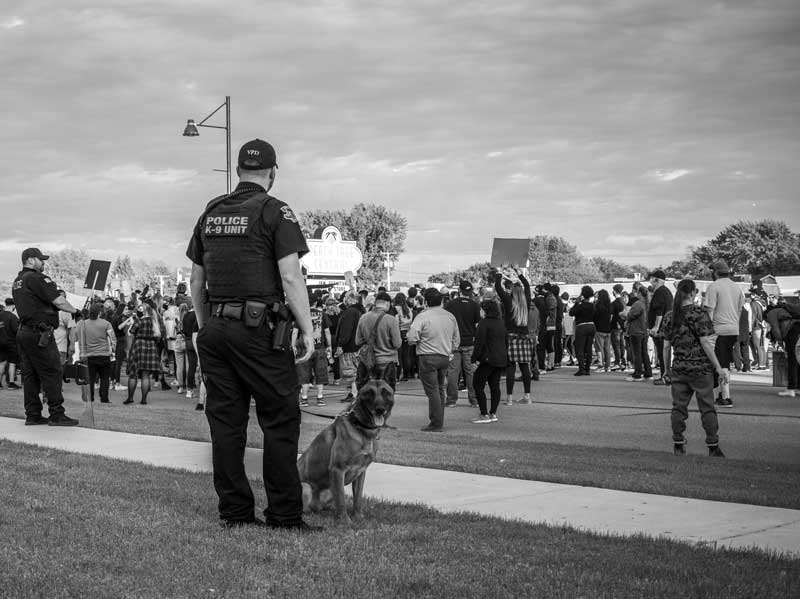We’ve talked about therapy and service dogs before but this time we decided to take a look at police dogs; also known as K-9/K9 (a homophone of canine). A common misconception is that police dogs are vicious creatures; when in reality they are just regular dogs with a very special skill set and part of their training is in discernment. Although they are sociable, these K-9s are trained to keep their composure in often stressful situations. The history of dogs in law enforcement goes back to the Middle Ages with German Shepherds and Belgian Malinois being some of the most common breeds that are employed. However, there are other breeds like Labrador Retrievers, Bloodhounds, and Basset Hounds that are known for their unique talents like trailing, tracking, and detection skills. Police K-9s usually serve in the force anywhere from six to nine years and in many countries, it is a criminal offense to injure or kill a police dog.
The requirement of a dog to be enlisted into the force is to first pass basic obedience training where they must be able to respond to and obey the commands of their handler without hesitation for the necessary control. There are two classifications of police K-9s; patrol and detection. Patrol dogs help with patrol duties like suspect apprehension, officer protection, security in high-alert/controlled areas, and area or building clearance. Detection dogs help in finding either narcotics or explosives and are mutually exclusive of the other because they are trained specifically for that job. There are two classifications for law enforcement dogs and they are trained to either be “single purpose” or “dual-purpose” K-9s. Single-purpose dogs are used mostly for either patrol duties or detection duties. There are some single-purpose K-9s that are used only for tracking, lost person location, or cadaver detection. Now, dual-purpose dogs are trained to combine these duties in one K9. In the United States, once a K-9 indicated to its handler that it has detected the odor of narcotics, the officer then has reasonable cause to search without a warrant.

The Process
Every training starts with shaking the handler’s hand and petting each dog on the head. Each duo made up of the K-9 handler and the special pooch go through 240-hours of skilled training to make them an expert tea. Each K-9 handler is experienced in the police force before being paired with a dog. Most of each unit’s dogs work for six to seven years, starting between the ages of 18 months to three years old. During each shift, each K-9 takes part in 10-hour practice sessions with the unit and individual training with their handler.
In the case of the Fontana (CA) K-9 Unit, there is strong community involvement with a civilian-led support group called Fontana Police K9 Pals that raised funds to make sure each team has the required equipment to get their jobs done to protect and serve. This includes but is not limited to the donation of a training facility that houses a number of practice structures and equipment.
One of the most important aspects of the training is the police dog’s bite pressure and analyzing it is a key component. One of the common practices is the officers will take turns wearing a full bite suit and pretend to play the part of the suspect so the dogs can practice their apprehension skills. The objective is to have decoys who have learned to understand the dog’s behavior. It’s important to train pups who are not hesitant to take someone down and bites with enough pressure with a consistent hold until their handler commands otherwise. Fontana police K-9 vehicles are equipped to keep the canine officers safe even during the triple-digit temperatures that hit their area of California. Should the inside of the vehicle become too hot, the car’s fans turn on, windows roll down, and the horn goes off as does an alarm attached to the officer’s belt.
The proper gear is very important and it consists of various leashes (depending on the task), a lowering harness, and, occasionally, a muzzle. Some K-9 units use bullet-proof vests and others, do not, based on the fact that they can be cumbersome, hot, heavy and restrict the animal’s movement to maneuver in small spaces. If there is a high probability that a suspect has a gun and will use it, the officers will most likely find a solution to apprehend that does not include the dog.
Home-life and Beyond
K-9 pooches live with their handlers and the force has strict rules on what happens to the dogs when their handlers are not at home; even though they usually get along really well with everyone in the house. When their handlers are not there, the dogs must stay in their crate or kennels. When the police pups retire, their handlers have the option to buy them back from the city and keep them as their super well-behaved pets! Now as far as the officer, they will return to the traditional force once their partner retires.
Their diets consist of high-quality dog food to fuel their very active lifestyle and usually within the four to five cup range per day; with treats on occasion. As much as they may want it, no human food is allowed! Just like any other dog, they are groomed, will use flea/tick medication and their weight is monitored like an athlete to make sure they are ready for work for any potential task.
This was by far one of the most interesting topics we’ve been able to dive into here at Petlox and to go deeper into police dogs, visit nationalpolicedogfoundation.org. The National Police Dog Foundation promotes education and awareness, as well as raises funds for the purchase, training and veterinary care for active and retired police K-9s. Follow along on our Instagram @Petlox for more into the world of amazing animals!

